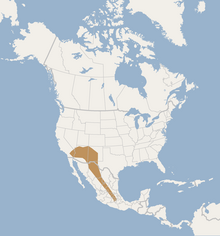Arizona myotis Contents Taxonomy and etymology Description Range and habitat Conservation References Navigation menu10.2305/IUCN.UK.2018-2.RLTS.T136650A21990499.en"Two new bats from the southwestern United States"e40568295426641174715946254136650138025192497118
IUCN Red List least concern speciesMouse-eared batsBats of the United StatesBats of MexicoMammals described in 1909Taxa named by Ned Hollister
vesper batspeciesUnited StatesMexicoDistrito FederaldescribedNed HollisterholotypeNeedles, Californiaspecies nameLatinSouthwestern United StatesChihuahualeast-concern speciesIUCNprotected areas
Arizona myotis
Jump to navigation
Jump to search
| Arizona myotis | |
|---|---|
Conservation status | |
 Least Concern (IUCN 3.1)[1] | |
Scientific classification | |
| Kingdom: | Animalia |
| Phylum: | Chordata |
| Class: | Mammalia |
| Order: | Chiroptera |
| Family: | Vespertilionidae |
| Genus: | Myotis |
| Species: | M. occultus |
Binomial name | |
Myotis occultus Hollister, 1909 | |
 | |
The Arizona myotis (Myotis occultus) is a vesper bat species inhabiting much of the southwestern United States and central Mexico as far south as the Distrito Federal.[1]
Contents
1 Taxonomy and etymology
2 Description
3 Range and habitat
4 Conservation
5 References
Taxonomy and etymology
It was described as a new species in 1909 by American zoologist Ned Hollister.
The holotype was collected near Needles, California in 1905.[2]
Its species name "occultus" is Latin for "hidden or concealed."
Description
It is a small species with a total length of 96 mm (3.8 in)— of the total length, 40 mm (1.6 in) consists of its tail.
Its fur is glossy brown with a cinnamon tint.
The ventral fur and its face are paler brown.[2]
Range and habitat
Its range includes parts of the Southwestern United States and the Mexican state of Chihuahua.
It is found in a range of elevations from near sea level to 2,806 m (9,206 ft) above sea level.[1]
Conservation
As of 2018, it is evaluated as a least-concern species by the IUCN.
It meets the criteria for this classification because it has a wide geographic range, its range includes protected areas, and it is not likely experiencing rapid population decline.[1]
References
^ abcd Solari, S. (2018). "Myotis occultus". The IUCN Red List of Threatened Species. 2018: e.T136650A21990499. doi:10.2305/IUCN.UK.2018-2.RLTS.T136650A21990499.en..mw-parser-output cite.citationfont-style:inherit.mw-parser-output .citation qquotes:"""""""'""'".mw-parser-output .citation .cs1-lock-free abackground:url("//upload.wikimedia.org/wikipedia/commons/thumb/6/65/Lock-green.svg/9px-Lock-green.svg.png")no-repeat;background-position:right .1em center.mw-parser-output .citation .cs1-lock-limited a,.mw-parser-output .citation .cs1-lock-registration abackground:url("//upload.wikimedia.org/wikipedia/commons/thumb/d/d6/Lock-gray-alt-2.svg/9px-Lock-gray-alt-2.svg.png")no-repeat;background-position:right .1em center.mw-parser-output .citation .cs1-lock-subscription abackground:url("//upload.wikimedia.org/wikipedia/commons/thumb/a/aa/Lock-red-alt-2.svg/9px-Lock-red-alt-2.svg.png")no-repeat;background-position:right .1em center.mw-parser-output .cs1-subscription,.mw-parser-output .cs1-registrationcolor:#555.mw-parser-output .cs1-subscription span,.mw-parser-output .cs1-registration spanborder-bottom:1px dotted;cursor:help.mw-parser-output .cs1-ws-icon abackground:url("//upload.wikimedia.org/wikipedia/commons/thumb/4/4c/Wikisource-logo.svg/12px-Wikisource-logo.svg.png")no-repeat;background-position:right .1em center.mw-parser-output code.cs1-codecolor:inherit;background:inherit;border:inherit;padding:inherit.mw-parser-output .cs1-hidden-errordisplay:none;font-size:100%.mw-parser-output .cs1-visible-errorfont-size:100%.mw-parser-output .cs1-maintdisplay:none;color:#33aa33;margin-left:0.3em.mw-parser-output .cs1-subscription,.mw-parser-output .cs1-registration,.mw-parser-output .cs1-formatfont-size:95%.mw-parser-output .cs1-kern-left,.mw-parser-output .cs1-kern-wl-leftpadding-left:0.2em.mw-parser-output .cs1-kern-right,.mw-parser-output .cs1-kern-wl-rightpadding-right:0.2em
^ ab Hollister, N. (1909). "Two new bats from the southwestern United States". Proceedings of the Biological Society of Washington. 22: 43–44.
Categories:
- IUCN Red List least concern species
- Mouse-eared bats
- Bats of the United States
- Bats of Mexico
- Mammals described in 1909
- Taxa named by Ned Hollister
(RLQ=window.RLQ||[]).push(function()mw.config.set("wgPageParseReport":"limitreport":"cputime":"0.924","walltime":"1.197","ppvisitednodes":"value":7923,"limit":1000000,"ppgeneratednodes":"value":0,"limit":1500000,"postexpandincludesize":"value":52356,"limit":2097152,"templateargumentsize":"value":5451,"limit":2097152,"expansiondepth":"value":17,"limit":40,"expensivefunctioncount":"value":8,"limit":500,"unstrip-depth":"value":1,"limit":20,"unstrip-size":"value":6683,"limit":5000000,"entityaccesscount":"value":9,"limit":400,"timingprofile":["100.00% 1076.972 1 -total"," 59.73% 643.270 1 Template:Speciesbox"," 58.87% 634.061 1 Template:Taxobox/core"," 19.69% 212.007 1 Template:Taxonbar"," 14.58% 156.999 1 Template:Reflist"," 12.77% 137.539 2 Template:Cite_journal"," 9.45% 101.812 43 Template:Delink"," 3.72% 40.018 3 Template:Convert"," 2.33% 25.113 1 Template:Taxonomy"," 1.88% 20.274 1 Template:Speciesbox/name"],"scribunto":"limitreport-timeusage":"value":"0.658","limit":"10.000","limitreport-memusage":"value":4907907,"limit":52428800,"cachereport":"origin":"mw1253","timestamp":"20190606142005","ttl":2592000,"transientcontent":false););"@context":"https://schema.org","@type":"Article","name":"Arizona myotis","url":"https://en.wikipedia.org/wiki/Arizona_myotis","sameAs":"http://www.wikidata.org/entity/Q1831736","mainEntity":"http://www.wikidata.org/entity/Q1831736","author":"@type":"Organization","name":"Contributors to Wikimedia projects","publisher":"@type":"Organization","name":"Wikimedia Foundation, Inc.","logo":"@type":"ImageObject","url":"https://www.wikimedia.org/static/images/wmf-hor-googpub.png","datePublished":"2008-09-15T06:06:12Z","dateModified":"2019-03-06T16:28:47Z","image":"https://upload.wikimedia.org/wikipedia/commons/6/68/Distribution_of_Myotis_occultus.png","headline":"species of mammal"(RLQ=window.RLQ||[]).push(function()mw.config.set("wgBackendResponseTime":101,"wgHostname":"mw1320"););